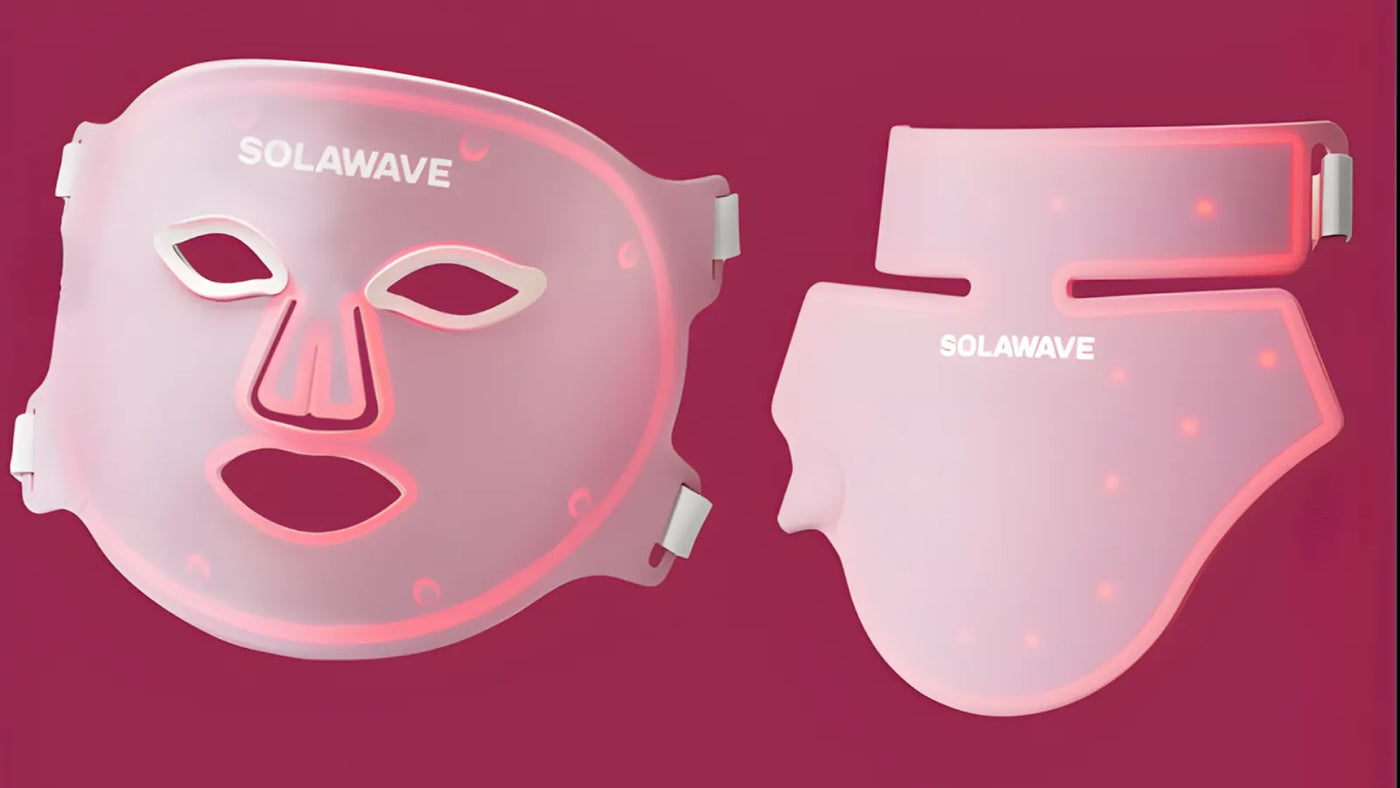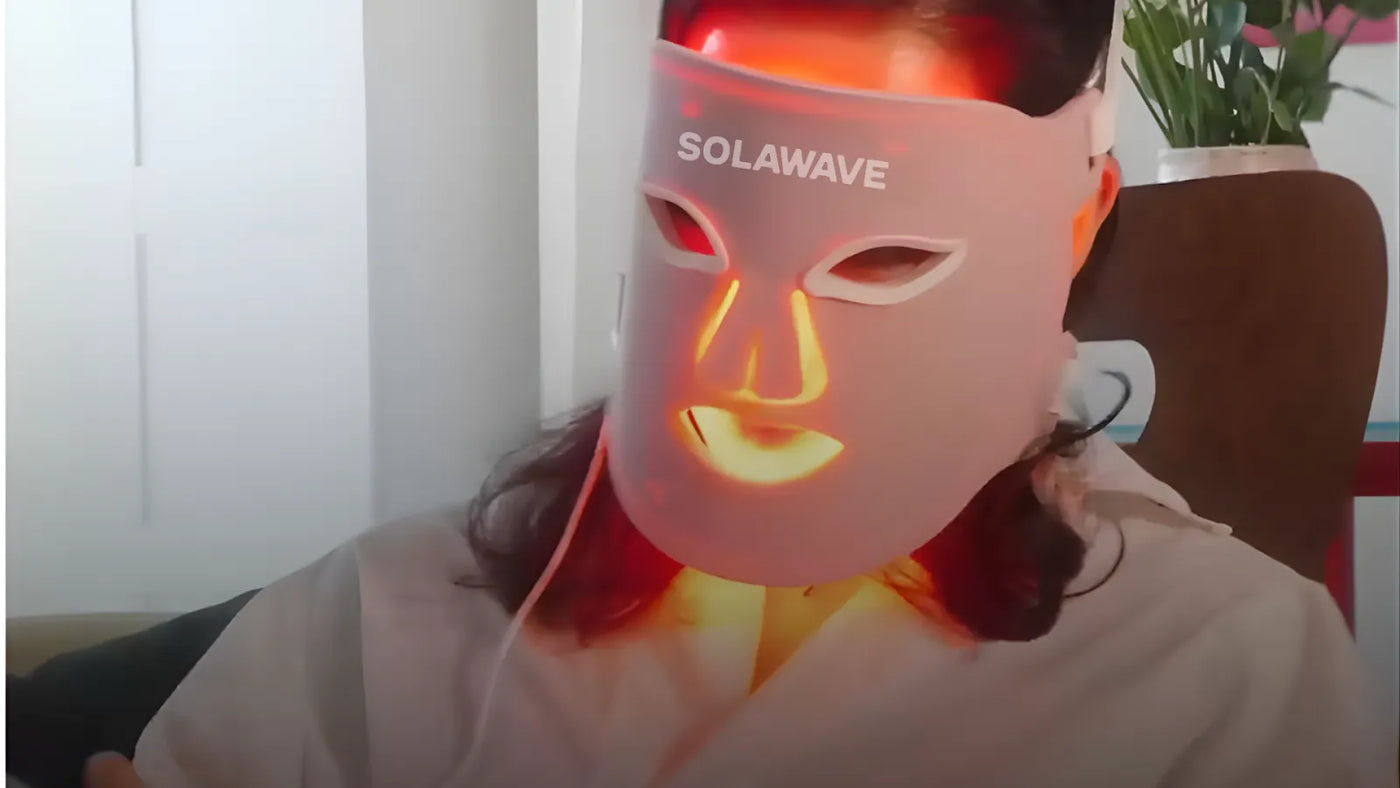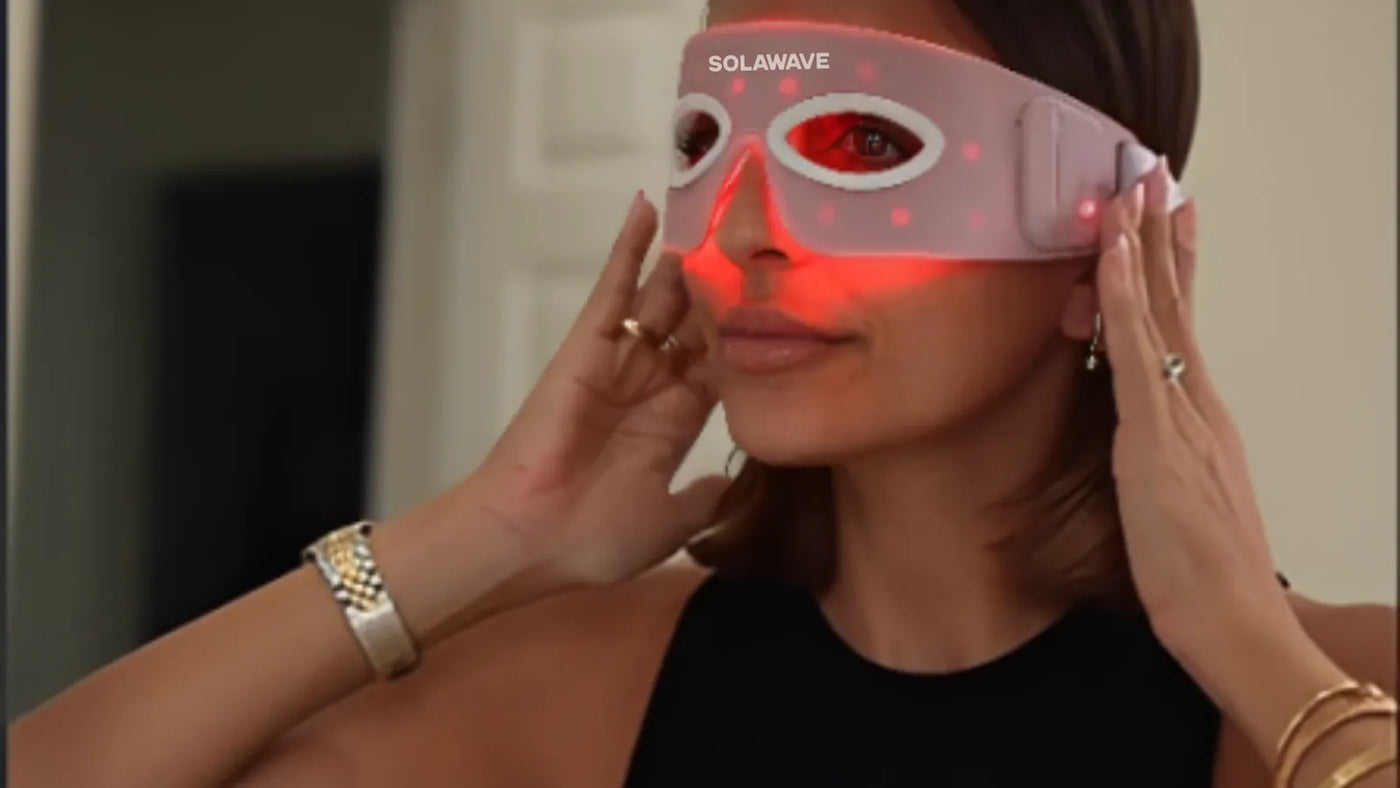
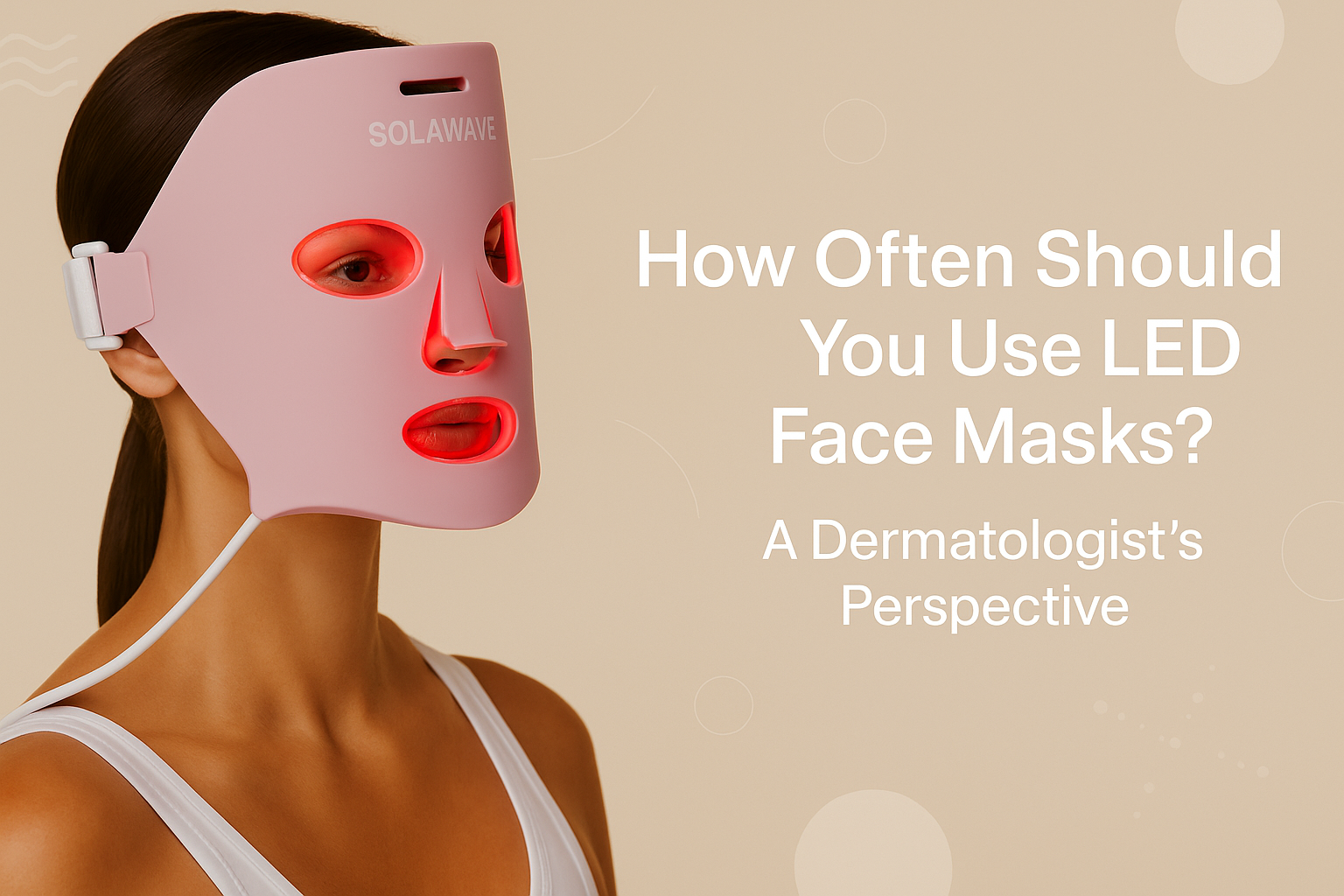
How Often Should You Use LED Face Masks? A Dermatologist's Perspective
LED light therapy masks have become a staple in modern skincare, promising visible improvements in skin texture, firmness, and radiance. But the most common question remains: how often should you use LED face mask for optimal results? This article, inspired by leading research and dermatologist opinions, explores the science, best routines, and expert advice for getting the most from your red light mask
What Are LED Face Masks and How Do They Work?
LED face masks use targeted wavelengths of red and near-infrared light to penetrate the skin, stimulating cellular processes that drive rejuvenation. Red light (typically 600–700 nm) reaches deep into the skin, energizing skin cells and boosting collagen and elastin production. This process, known as photobiomodulation, is the foundation of the mask’s anti-aging and healing benefits.
![A rose gold SolaWave [BINAERY] 4-in-1 Radiant Renewal Skincare Wand stands by a serum bottle, highlighting advanced skin technology for reducing fine lines. Award badges from leading magazines are displayed to the right. || Rose Gold](https://www.solawave.co/cdn/shop/files/Updated-_RadiantRenewalSkincareWandKitLightBoostSerum-RoseGold_1200x_c979c64a-44e4-4f0c-9110-00c7cd0d18f5.webp?v=1733859035&width=900) POPULAR
POPULAR 
What Does the Research Say About Red Light Masks?
Clinical Evidence
-
Improved Skin Elasticity and Firmness:
A randomized controlled trial(1) found that participants using home-use LED devices at 637 and 854 nm wavelengths experienced significantly higher skin elasticity after 6 and 8 weeks compared to a control group. This supports the claim that LED face mask frequency-when consistent-can yield measurable improvements in skin firmness.
-
Reduction in Wrinkles and Fine Lines:
A 2024 review (2) highlighted that red light therapy mask reduces wrinkles, enhances skin firmness, and improves overall skin texture. Another study published in 2023 (3) demonstrated that red light photobiomodulation can reverse visible signs of aging within just one month of use by stimulating collagen and elastin synthesis in the skin.
-
Boosted Collagen and Cellular Repair:
Red light activates cytochrome c oxidase in skin cells (basically, it helps your skin’s energy factories work better, giving your skin a healthier, more youthful look), increasing energy production, which enhances cell metabolism and repair. This mechanism is linked to increased fibroblast activity, collagen production, and improved tissue regeneration.
-
Acne and Inflammation:
Red light therapy has also shown promise in reducing inflammation and supporting acne treatment, especially when combined with blue light. The anti-inflammatory effect helps calm redness, speed healing, and minimize post-acne scarring.
 $104 Savings
$104 Savings 
Safety Profile
Clinical studies and dermatologist reviews agree that LED face masks are generally safe for most people, with a very low risk of side effects when used as directed. Overuse or misuse, however, can lead to temporary skin irritation or dryness.
Dermatologist Opinions: In Favor of Red Light Masks
Dermatologists widely support the use of red light masks for skin health, especially for anti-aging and inflammation reduction:
“Red light is primarily used for its anti-aging benefits, such as collagen stimulation and reduced inflammation.” Dr. Elika Hoss, Mayo Clinic
“Red-light therapy can reduce the appearance of wrinkles, pigmentation, broken blood vessels, and improve the skin’s elasticity and hydration.” Dr. Jennifer Sawaya, U.S. Dermatology Partners Scottsdale
“Red light and near-infrared light wavelengths really help to reduce inflammation and create collagen.” Dr. Ayah, Dermatologist
“The mitochondria in your cells soak up energy from red light to produce more energy in the skin, healing and repairing damaged cells while promoting tissue and cell repair.” Dr. Anna Guanche, Dermatologist
“More than 90% of patients said they noticed some improvement, including softer and smoother skin, less redness, and lightening of dark spots.” American Academy of Dermatology
These endorsements reflect a growing consensus that LED face mask dermatologist recommendation is positive, provided users follow proper guidelines and device instructions.
 $152 Savings
$152 Savings 
How Often to Use LED Face Mask: Research-Backed Guidelines
General Recommendations
-
3–5 times per week:
Most studies and dermatologists recommend using an LED face mask 3–5 times a week for 10–20 minutes per session for best results. -
Consistency is key:
Regular use is essential. Sporadic sessions may delay or diminish results, while overuse can cause irritation. -
Follow manufacturer instructions:
Devices like the Wrinkle Retreat Red Light Therapy Mask are designed for safe, frequent use. Always adhere to the specific instructions provided with your device for optimal safety and effectiveness.
(Source: Created Internally)
Sensitive Skin Considerations
Start slow:
If you have sensitive or reactive skin, begin with 2–3 sessions per week and monitor your skin’s response. If irritation occurs, reduce frequency and consult a dermatologist.
 $126 Savings
$126 Savings 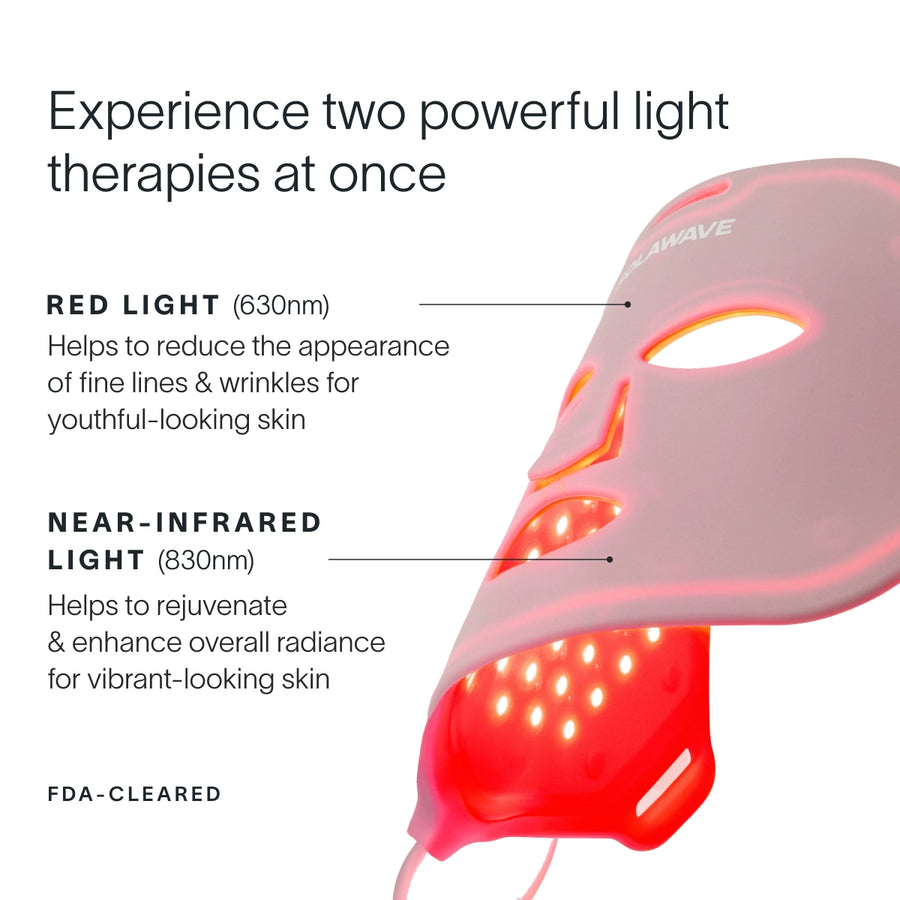
Best Way to Use LED Face Mask
Step-by-Step Routine
-
Cleanse thoroughly:
Remove all makeup and sunscreen so the light can penetrate effectively. -
Apply the mask:
Secure the mask comfortably on your face, ensuring full coverage. -
Session duration:
Use the mask for 10 minutes, as recommended. -
Aftercare:
Follow up with a hydrating serum or moisturizer to lock in benefits. Some experts recommend using a performance-enhancing serum before the mask to maximize results. -
Clean the device:
Wipe down the mask after each use to maintain hygiene.
Morning vs. Night: When Is Best?
-
Either is effective:
Morning use can energize your skin for the day, while evening use fits well into a relaxing nighttime routine. The key is consistency-choose the time that best suits your schedule.
LED Face Mask Frequency: Summary Table
| Frequency | Recommended For | Notes |
|---|---|---|
| Daily | Some devices, robust skin | Only if manufacturer allows and no irritation occurs |
| 3–5 times/week | Most users, all skin types | Ideal for visible results and minimal risk |
| 2–3 times/week | Sensitive or reactive skin | Start here if prone to irritation |
Results Timeline: What to Expect
-
1–2 weeks: Early improvements in skin tone and reduced inflammation.
-
4–6 weeks: Noticeable reduction in fine lines, smoother texture, and fading of dark spots.
-
8–12 weeks: Significant improvements in firmness, elasticity, and overall skin health, as confirmed by clinical studies.
Safety and Who Should Avoid LED Face Masks
-
Who should avoid:
People with light sensitivity, certain skin conditions (e.g., lupus, photosensitive eczema), or those using strong active ingredients should consult a doctor before starting. -
General safety:
At-home masks are generally safe for most people, with minimal risk of side effects when used as directed. -
Eye protection:
Always use goggles or shields provided, especially with blue light, to prevent eye discomfort or damage.
Choosing the Right Device
When selecting a mask, look for FDA-cleared devices and reputable brands. The Wrinkle Retreat Light Therapy Mask from Solawave is an example of an at-home device designed for safety and efficacy, using clinically proven wavelengths for skin rejuvenation.
Final Thoughts
The best way to use LED Red Light Therapy Face Mask is to follow a consistent, device-specific routine, typically 3–5 times per week for 10–20 minutes, prioritizing safety and comfort. Clinical research and dermatologist opinions strongly support the benefits of red light therapy for anti-aging, inflammation reduction, and overall skin health. For those seeking a non-invasive, evidence-based approach to skincare, red light masks are a worthwhile addition to your routine.
By adhering to expert guidance on LED face mask frequency and best practices, you can safely and effectively harness the power of light therapy for healthier, more youthful-looking skin. For advanced devices and more information, visit Solawave.
FAQs
Q. Is it okay to use a LED face mask every day?
For most people, yes—if the device is designed for daily use and your skin tolerates it well. However, most users see optimal results with 3–5 sessions per week.
Q. How often can I use my LED light therapy mask?
Generally, 3–5 times per week for 10 minutes per session is ideal. Always check your device’s manual for specific guidance.
Q. What is the best routine for a LED mask?
-
Cleanse your skin
-
Use the mask for the recommended duration
-
Apply moisturizer or serum after
-
Stick to a consistent schedule
Q. Is it better to use your LED mask at night or in the morning?
Both are effective. Choose the time that fits best with your routine and stick to it.
Sources:
Choi, J. W., Kim, B. R., & Youn, S. W. (2020). Efficacy of home-use light-emitting diode device at 637 and 854-nm wavelengths for facial rejuvenation: A prospective split-face clinical trial. Lasers in Surgery and Medicine, 52(6), 523–531. https://pubmed.ncbi.nlm.nih.gov/32649063/
Le Thi Nhu, N., Ju-Young, M., & Young-Chul, L. (2022). Utilization of light‐emitting diodes for skin therapy: Systematic review and meta‐analysis. Photodermatology, Photoimmunology & Photomedicine, 38(5), 405–416. https://onlinelibrary.wiley.com/doi/10.1111/phpp.12841
Dai, T., Huang, Y. Y., & Hamblin, M. R. (2018). Light‐emitting diodes in dermatology: A systematic review of randomized controlled trials. Lasers in Surgery and Medicine, 50(6), 613–628. https://pmc.ncbi.nlm.nih.gov/articles/PMC6099480/




















